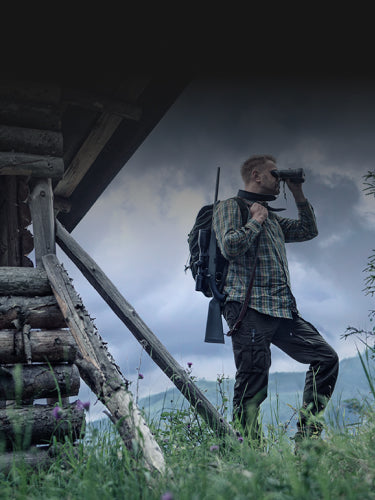Thermal imaging turns heat into vision. Every object on Earth emits infrared radiation—energy invisible to the naked eye but detectable by modern sensors. A thermal imager captures those minute differences in temperature and renders them as a visible image, revealing heat signatures where ordinary optics see nothing. Whether for night hunts, perimeter patrols, or wildlife observation, the ability to “see heat” gives users a decisive edge when visibility fails.
The Science Behind Thermal Imaging
Thermal imagers don’t rely on light. Instead, they detect infrared radiation—wavelengths beyond red light—and translate those temperature readings into electronic signals. These are then displayed as gradients of color or grayscale. Hotter objects appear brighter; cooler ones darker.
Unlike night vision, which amplifies existing light, thermal imaging functions in total darkness, through smoke, fog, or brush. It’s as close as one can get to true invisibility detection—recognizing life, machinery, or movement purely by heat.
Primary Uses of Thermal Imaging
Hunting and Game Recovery
Hunters use thermal imaging to locate animals hidden by terrain, foliage, or darkness. A whitetail’s body heat stands out sharply against cool undergrowth. After a shot, thermal binoculars can track a faint heat trail or locate a downed animal long after sunset.
Thermal optics like the Merger LRF XP35 Thermal Binoculars excel here—offering a wide field of view and precise laser-rangefinder capability, allowing hunters to scan, identify, and measure distance without switching devices.
Law Enforcement and Security
For police, security professionals, and first responders, thermal imaging exposes what shadows conceal. Officers can detect suspects hiding in darkness, search buildings after hours, or identify recently used vehicles by residual engine heat.
Border and perimeter patrols rely on thermal binoculars for silent, long-range observation where traditional lights or flashlights would compromise stealth.
Search and Rescue
Thermal imaging saves lives. A missing hiker, crash survivor, or stranded boater radiates heat that stands out even through fog, smoke, or light foliage. Rescue crews can sweep large areas quickly, spotting what would otherwise remain unseen.
Handheld and binocular thermal devices give responders flexibility to scan from the air, shore, or vehicle—day or night.
Wildlife Observation and Conservation
Biologists and outdoor enthusiasts use thermal imaging to study nocturnal animals without disturbing them. From counting deer populations to tracking endangered species, thermal technology captures behavior that traditional optics cannot.
Binoculars like the Merger LRF XP35 provide stable, high-resolution imaging ideal for quiet field observation across vast landscapes.
Industrial and Home Inspection
Thermal imaging has also become a diagnostic tool. Inspectors use it to detect heat leaks, electrical faults, overloaded circuits, or water damage behind walls. Farms and ranches use it to monitor livestock health or locate escaped animals at night.
In every case, thermal technology reduces guesswork, turning invisible data into visible insight.
Advantages of Thermal Binoculars
While riflescopes and monoculars have their roles, binoculars deliver superior depth perception, stability, and scanning efficiency. The Merger LRF XP35 combines Pulsar’s high-resolution 640 × 480 sensor with precision laser ranging—allowing users to spot, identify, and measure distance instantly. Dual eyepieces reduce eye strain during long sessions, while the integrated rangefinder makes it a self-contained observation system for hunters, law enforcement, or researchers alike.
Beyond Darkness
Thermal imaging isn’t limited to night. It reveals the unseen during day or dusk, cutting through camouflage, vegetation, and glare. It shows the living world by its energy, not its appearance—a technology that continues to find new uses across hunting, security, and science.
For those who rely on absolute situational awareness, the future of sight lies in heat.
Explore the Pulsar Merger LRF XP35 Thermal Binoculars to see how far modern thermal imaging can reach.
Frequently Asked Questions
How does thermal imaging work?
Thermal imaging detects infrared radiation emitted by objects and converts those temperature differences into a visible image. Hotter areas appear brighter and cooler areas appear darker, allowing users to see heat rather than light.
How is thermal imaging different from night vision?
Night vision amplifies available light, while thermal imaging operates entirely on heat. Thermal devices work in total darkness and maintain visibility through smoke, fog, brush, or other visual obstructions where night vision struggles.
What are thermal binoculars used for?
Thermal binoculars are used for hunting, law enforcement, wildlife observation, search and rescue, and industrial inspection. They offer stable two-eyed viewing for better depth perception and long-range scanning.
Why choose thermal binoculars over a monocular or riflescope?
Binoculars reduce eye strain, provide stronger depth perception, and improve scanning efficiency. They are ideal for long observation sessions and situations where identifying movement across wide terrain matters.
Can thermal imaging be used during the day?
Yes. Thermal imaging works regardless of lighting conditions and can reveal heat signatures even in daylight, through glare, camouflage, or dense vegetation.




